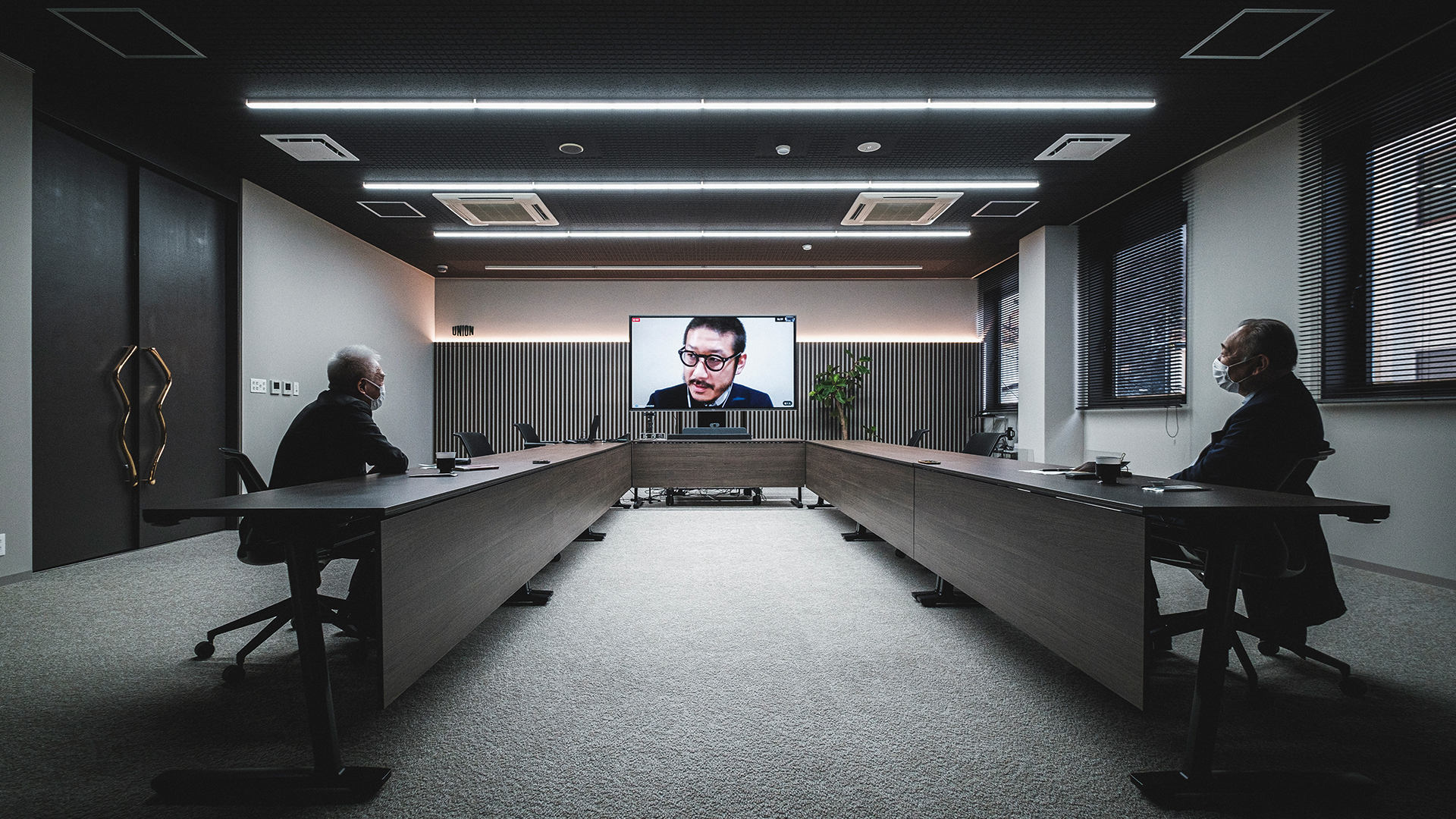
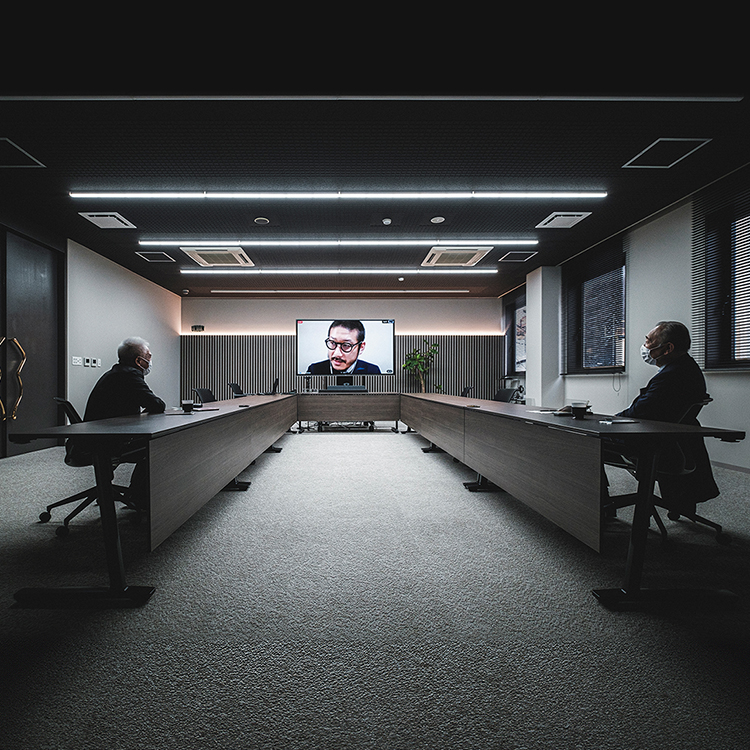


Junzo Tateno
CEO of UNION Corporation
Born in 1947, Junzo Tateno graduated from the Faculty of Law at Konan University (Kobe, Japan) in 1970
and entered Aoki Construction that same year. He joined UNION in 1973 and became CEO and President in 1990.
He serves as Chairman of the Union Foundation for Ergodesign Culture, a Public Interest Incorporated Foundation,
and the Osaka Industrial Bureau. He is also Vice Chairman of the Osaka Chamber of Commerce and Industry.
Kunihiko Morinaga
Born in 1980, Kunihiko Morinaga graduated from Waseda University's School of Social Sciences. While in university. Morinaga attended the Vantan Design Institute where he began making clothes. In 2003, he started his work on ANREALAGE and, in 2005, made his debut at Tokyo Fashion Week held at Tokyo Tower. In the same year, he won the GEN ART 2005 Avant-garde prize for young designers in New York. After 10 years of continuous involvement in Tokyo Fashion Week, Morinaga began presenting at Paris Fashion Week in 2014. He was selected as a finalist for the ANDAM FASHION AWARD in 2015 in France. In 2017, ANREALAGE held the "A LIGHT UN LIGHT exhibition in Japan as well as the traveling exhibition JAPAN HOUSE in LA and Sao Paulo, and also participated in exhibitions at the Pompidou Center Metz, Rothschild Museum, and Mori Art Museum. In 2019, he was selected as a finalist for the LVMH Prize in France, and won the 37th Mainichi Fashion Grand Prix in the same year. In 2020, Morinaga presented a collaboration collection with Fendi from Italy for Milan Fashion Week. He also designed the official uniform for the Japan Pavilion at Expo 2020 Dubai, which was held in 2021.
Nobuyuki Ohta
Born in 1953, Nobuyuki Ohta traveled to New York after graduating from Meiji University's Department of Business Administration. He spent eight years working as an intermediary between the American and Japanese fashion industries, serving in a variety of roles such as special correspondent to the Senken Shimbun newspaper, coordinator at Barneys New York, and marketing director for the National Association of Men's Sportswear Buyers. In 1985, he established the Council of Fashion Designers. Tokyo (CFD) and acted as its secretary-general. Ohta initiated the Tokyo Collection. He became president and CEO of ISSEY MIYAKE INC. in 2000 and, in 2006, served as an executive committee member for Japan Fashion Week (JFW). He helps manage the Tokyo Collection as well as actively supports up-and-coming designers. In 2013, he became president and CEO of Cool Japan Fund Inc, and, in 2018 after leaving this post, established MD-03 Inc. To this day, he is still a driving force in Japan's fashion industry.
16
TATENO
The ANREALAGE logo is really well designed. You must have spent a lot of time working on it.
MORINAGA
Based on the concepts of “ordinary” and “extraordinary,” I created this brand with the intention of expressing something fantasy-like that arises when two opposites are joined together through fashion. While the letters A and Z from the alphabet we all know appear to be far apart at first glance, when placed along a curved rather than a straight line, they appear right next to each other. I created the ANREALAGE logo with the desire of expressing this intersection of opposites through the brand itself.
TATENO
Before, you announced a collection based on the theme of “○△□.” That really left a deep impression. How did you arrive at this theme?
MORINAGA
The basic concept behind fashion is to make things according to the shape of the human body. In my “○△□” collection, I looked at how to create clothing separate from the human body as I designed my pieces. Spheres, trigonal pyramids, and cubes are shapes far removed from the forms of the human body. It’s thought that no one on the planet looks good in these figures. That said, I thought that maybe these shapes that don’t suit anyone just might give rise to new forms through fashion. This is the concept upon which I decided to base this collection.
TATENO
I see.
MORINAGA
In fact, we are the ones who produced the uniforms for the Japan Pavilion at the Dubai World Expo. This time, we created a sphere-shaped jacket for the uniform. Both men and women, tall and short, wore the same sphere, limiting the uniform to a single shape. We proposed this uniform as one that was gender neutral.
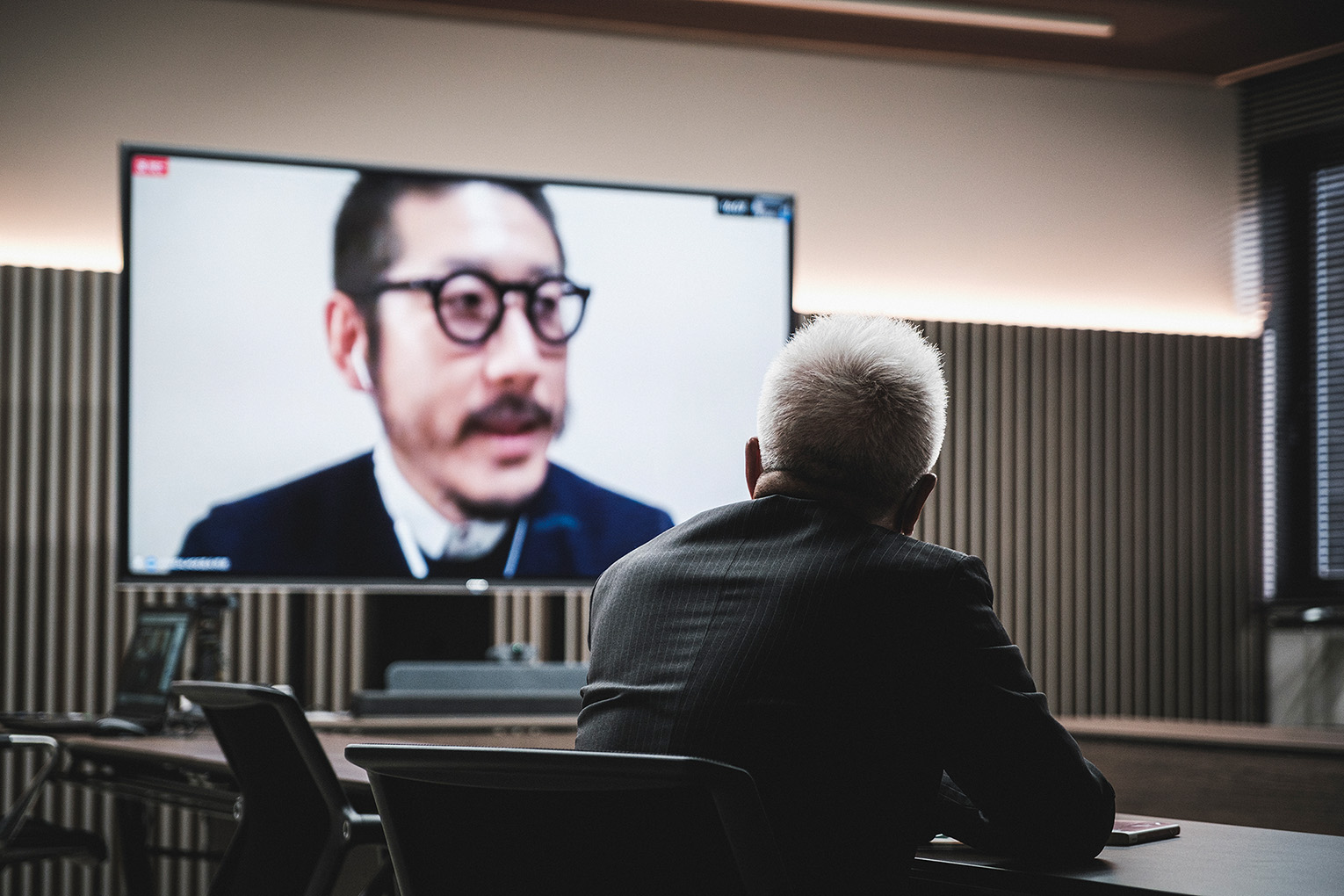
TATENO
What was the impression of the actual people who ended up wearing this uniform?
MORINAGA
If all the buttons are fastened, the garment becomes spherical and cannot be worn. It is up to the individual where to fasten the buttons, so the garment can be worn as the wearer prefers or finds comfortable. As such, the jacket has a different look depending on the person who is wearing it.
TATENO
Were the measurements the same for everyone?
MORINAGA
A diameter of 60cm is the standard for the spheres we make.
TATENO
I know that you focus on making things by hand but how about this time around?
MORINAGA
At first, we make them many times by hand in a process of trial and error.
TATENO
Coincidentally, we also have door handles in round, triangular, and square motifs.
MORINAGA
Are the door handles themselves made in those shapes?
TATENO
The base and the part of the handle that people actually grip come in round, triangular and square shapes. The material for the handles is metal. This series has been really well received and adopted on a variety of architectural structures. People have really enjoyed how well the handles match with unique architectural works.
MORINAGA
I believe door handles are expected to conform to the hand, but the first time these handles are touched must create a sense of awkwardness. I can imagine that spheres are easy to grab hold of but how about the other shapes?
TATENO
The triangular shaped handle was well received as it really conveyed the sense of being gripped.
MORINAGA
I personally like to break down conventional ideas or conceptions. I’m sure that when you take that door handle in your hand it gives you time to think about whether to turn, pull, or push it. I get the sense that it leads to a new kind of thinking which makes it really interesting to me.
TATENO
Thank you. If we get the chance, I’d like you to take a look at it some time. At UNION, we would love to work on an architectural project together with a fashion designer like you.
OHTA
I interact with a lot of designers, but I can tell that Mr. Morinaga really places a lot of importance on his words. While he makes a lot of mysterious works, I get the feeling that he really values his words throughout the process.
MORINAGA
Thank you very much.
OHTA
My impression of Mr. Morinaga is that of the philosopher Hegel. The word “dialectic” appears in Mr. Morinaga’s writings, which reminded me of Hegel’s thinking. I could also tell he is really meticulous in his calculations. This unconventional character of his makes his process of creation much different from other designers. In a sense, he is like an architect.
MORINAGA
Dialectics is one of the concepts I uphold when making something. Put simply, dialectics means thinking about things from an opposite perspective. For example, if we have clothes that are made to fit the body, what about thinking about clothes that fit no one’s body. Like the “○△□” we spoke of earlier, I like thinking about what kind of new forms will be created when something is matched to the human body. Rather than choosing something from the start based on my own feelings and tastes, I prefer to decide on a theme or concept and then think about how to approach it from different angles.
OHTA
There are a lot of designers out there, and many of them rely on their own tastes, senses, and aesthetics above all else. Designers like Mr. Morinaga, on the other hand, are quite rare in that they place importance on words and themes. I bet he spends a lot of time and energy pursuing the concepts and themes he establishes. Am I right?
MORINAGA
Exactly.
OHTA
Mr. Morinaga is a designer whose projects give off much the same feeling as industrial design. This is why I think you would be able to make something really interesting if the two of you collaborated on something.
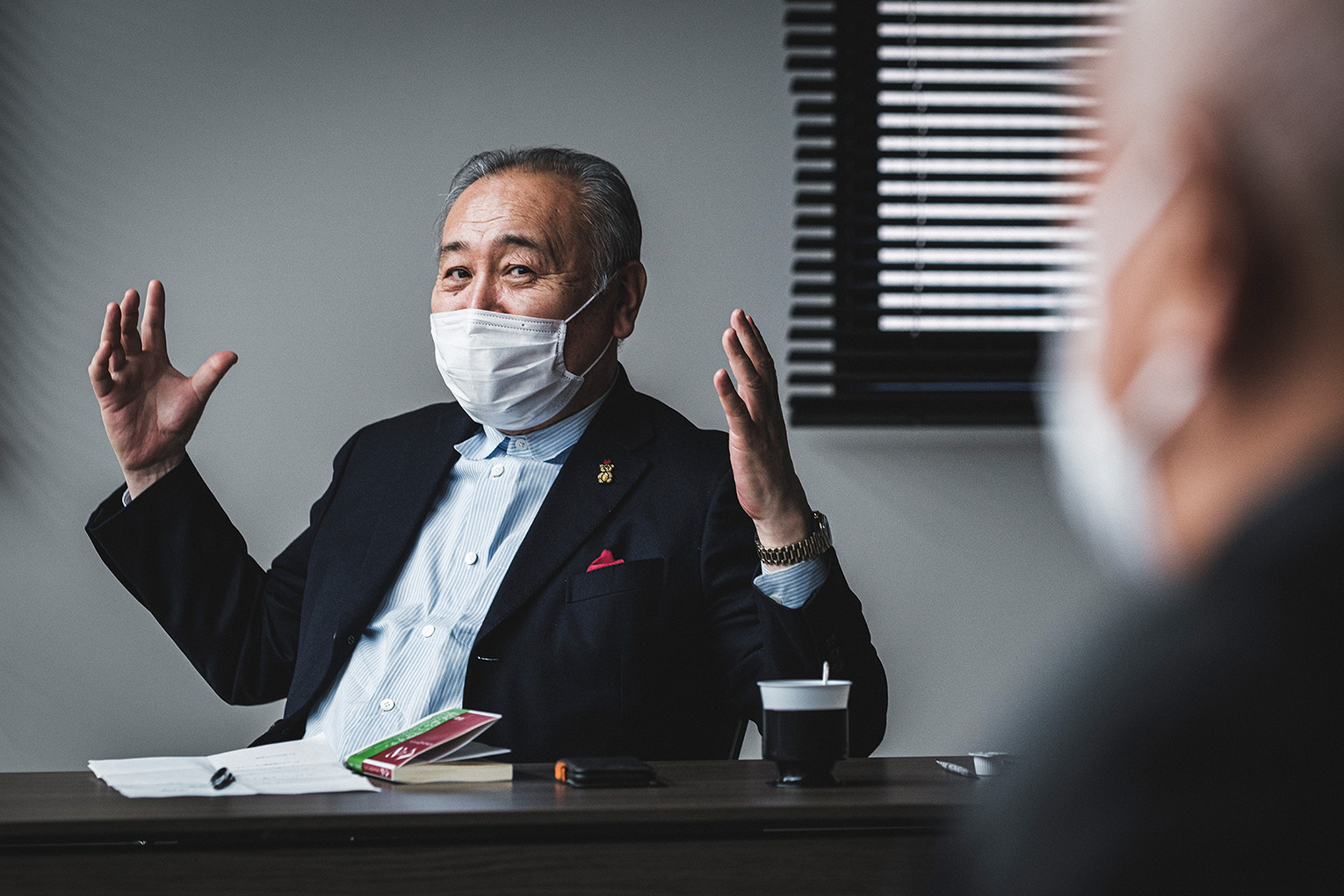
TATENO
Returning to an earlier topic for a second, your academic background is completely unrelated to fashion, isn’t it? When did you start to take an interest in fashion and begin studying it?
MORINAGA
I always really liked fashion, but rather than wearing clothes to express some kind of message, I simply enjoyed fashion as a consumer during my high school days. Right at that time brands like ISSEY MIYAKE, Yohji Yamamoto, and Comme des Garçons put on a really exciting show in Tokyo. I saw footage of the show through some fashion channel and remember thinking that there are really some amazing people out there.
TATENO
Does this mean that you were thinking about pursuing some line in fashion around the time that you were about to graduate high school?
MORINAGA
My father graduated from Waseda University and ended up working as a public servant afterwards. I, myself, thought about building some type of career like my father when I was taking the entrance exams for university.
TATENO
Is that right?
MORINAGA
I was attending a preparatory school when taking my university entrance exams, but at the time the internet had not spread to nearly the extent it has today, nor was there any social media. At an age when I did have much access to a wide range of information, one of the instructors at my preparatory school started talking about ISSEY MIYAKE and Comme des Garçons during class. That teacher also discussed other topics like movies and music. As such, I was able to learn a bit about fashion and culture while attending my preparatory school. There were a lot of indie brands at this time, and my teacher told me that there were people making clothes in school fashion clubs while studying at Waseda University.
TATENO
Wow.
MORINAGA
One day the teacher brought some of the clothes that were made by Waseda University students to our preparatory school. The clothes were completely asymmetrical with a mysterious shape that made one wonder how somebody would wear them. The shape of the clothes was completely different from what I had been used to up until then. My teacher told us that the creators of these clothes thought about not just wearing them but how to express themselves in the finest details of the design. Hearing this story, I realized that fashion could be used to express something; that a concept could be created and a story could be spun with a single piece of clothing. I had no idea then that such things could be expressed through clothing, which was very shocking to me.
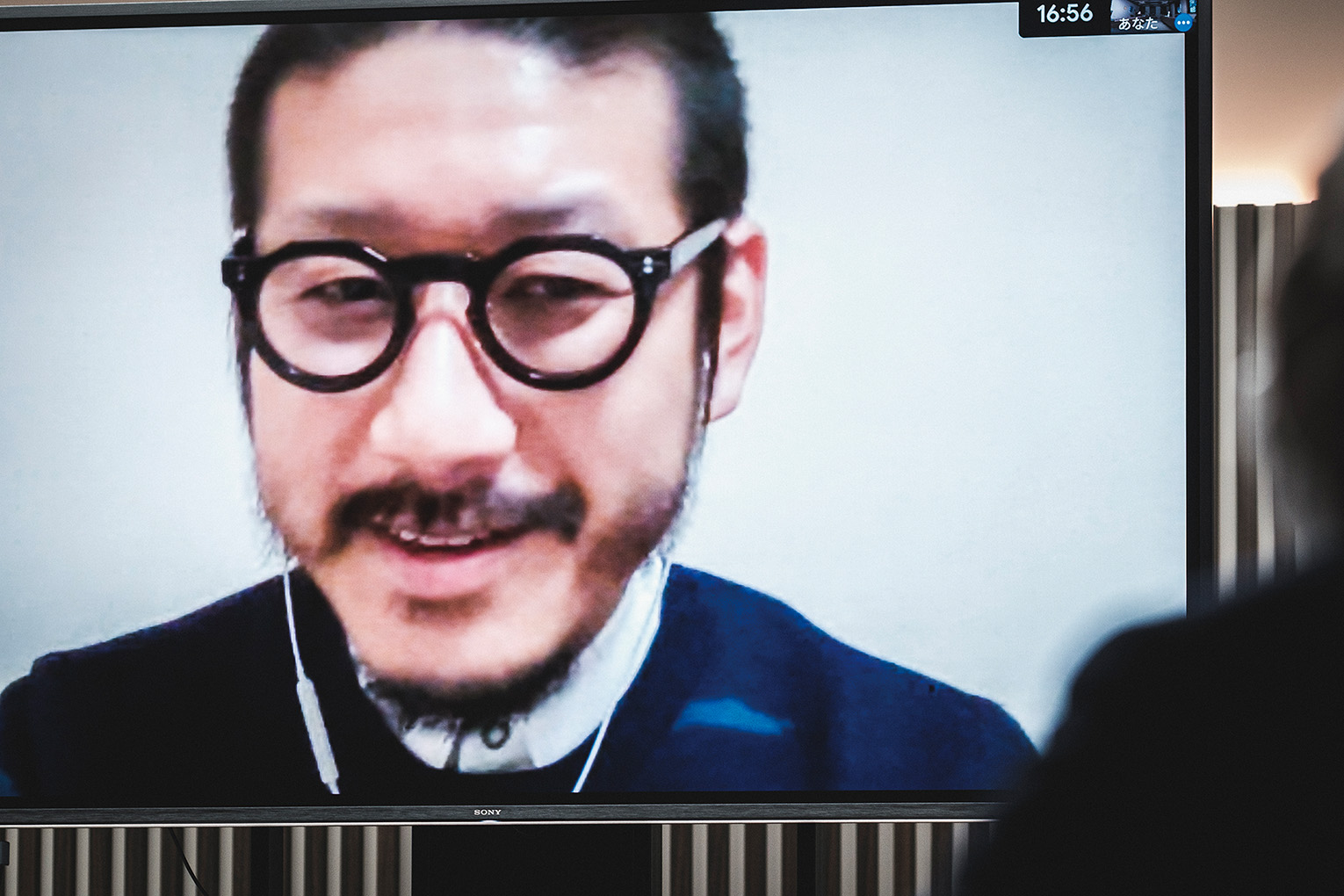
TATENO
I see.
MORINAGA
One day I heard that the student who made this clothing was part of the School of Social Sciences at Waseda University, and wanting to become their pupil, I decided to try and enter the same school and field of study as them. *Laughs.* From that point on, I became more and more involved in the field of fashion.
OHTA
That all being said, you really were lucky to encounter such a great instructor at preparatory school.
MORINAGA
I was. That teacher was also the one who taught me about Hegel and dialectics.
TATENO
So if you hadn’t had this experience at preparatory school, you may never have entered the world of fashion in the end.
MORINAGA
That’s right.
OHTA
But you had your sights set on becoming a fashion designer from the time you entered college, didn't you? You had your goal and studied doubly hard to achieve it, all the while committing to making a living through fashion after graduation. That’s quite early to make such a decision for your future.
MORINAGA
Once I make up my mind, I’m determined to see things through. That said, my parents were worried. I knew that my parents could not be unconditionally happy that their son had decided to make a living as a fashion designer.
OHTA
That is still the same now as it was then. Especially when a man decides to commit to a career in fashion, parents naturally tend to feel uneasy about this.
TATENO
I believe that fashion and architecture share something in common. Mr. Morinaga, when you look at architecture do you find any common points that you feel are shared with fashion?
MORINAGA
I really feel that something is shared between the two. If you are talking about things that separate or connect the human body from the space surrounding it, then either clothing or walls come to mind. While the perspectives may be different, the essence of architecture and clothing is very close in my mind. This includes my approach to making things.
TATENO
Do you ever get the opportunity to speak with architects?
MORINAGA
I sometimes get the opportunity to speak with architects like Tsuyoshi Tane and Junya Ishigami who are from the same generation as myself. I feel there are a lot of links when it comes to the topic of how to create something extraordinary out of the ordinary. I’ve spoken about many things with architects, such as how much functionality should be maintained or whether people’s lives should be enriched even at the expense of functionality.
TATENO
Is that right? The door handles we deal in are a constant fixture anywhere there is architecture. This is the same as the clothes you create. Wherever there are people, there is clothing. This is why I believe clothes are also something to be passed down to the next generation. At UNION, we maintain a spirit for always taking on new challenges with novel types of materials. How do you approach materials in your work?
MORINAGA
I try to make clothes that actively incorporate materials and fabrics I have never used before. The materials I’m talking about are not simply threads or dyes, but something much further. For example, I would like to expand the possibilities for pigments used to make dyes. In fact, we continually experiment with how to create new dyes. We are trying, for instance, to find out how light is reflected and how the color changes when exposed to ultraviolet rays. For this, we are working with companies like Mitsui Chemicals, Inc.
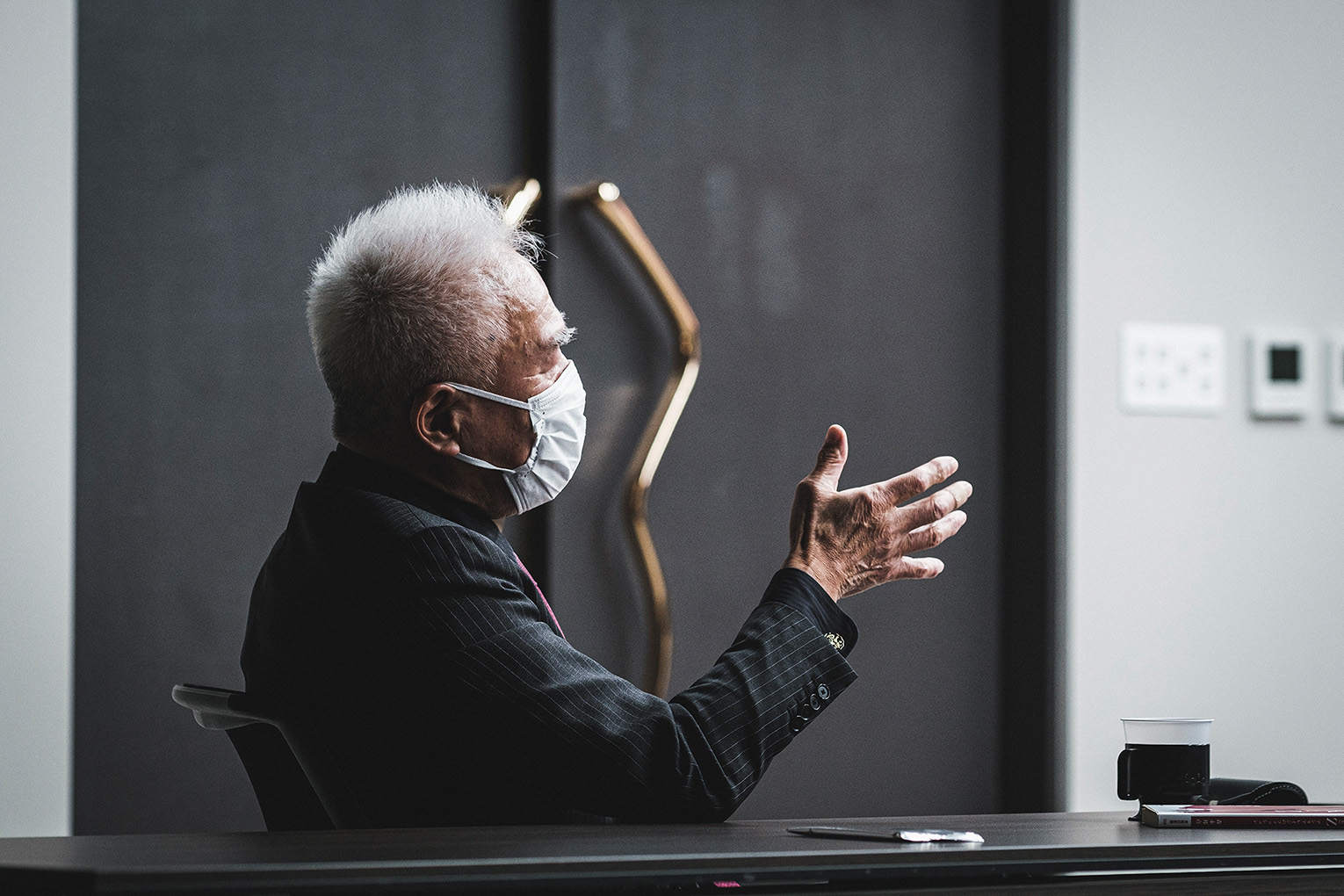
OHTA
Companies like Mitsui Chemicals are not the kind of names you typically hear in fashion circles. They are an industrial company, which makes things interesting. While fibers used for fashion are weaved at these factories on the one hand, these same factories also produce products for industrial use. I’m sure Mr. Morinaga is interested in both sides of this coin.
MORINAGA
There are many different types of fiber factories. There are your regular pattern makers as well as pattern makers that handle fabrics for architectural interiors, and the machines they use are all slightly different. It is interesting to note that the machines used to make car seats have a different application than other weaving equipment.
OHTA
Those fibers carry the functionality for blocking out sound and electromagnetic waves, don’t they? There is an Italian company called Moncler, which is famous for their down jackets, and their biggest supplier is actually a textile company based out in Fukui, Japan. The company originally made sails for yachts, and now they have gotten involved in fashion as well.
TATENO
Wow. My friend actually works at Taiyo Kogyo Corporation which specializes in making membranes for tents and other products.
MORINAGA
I actually had the pleasure of working with Taiyo Kogyo around one year ago.
TATENO
Is that right!?
MORINAGA
Yes. I used some of the membrane materials Taiyo Kogyo uses on their domes to create some clothing.
OHTA
Was this for the 2021 spring/summer collection that you had a photoshoot for at the foot of Mt. Fuji?
MORINAGA
That’s right.
TATENO
Please try working with metal for one of your next projects.
OHTA
Yes, maybe an untearable aluminum foil or some hardware that bends anyway you like it. *Laughs.*
TATENO
In 2019, you were selected as a finalist for the LVMH Young Fashion Designer Prize. How was your experience with this personally?
MORINAGA
That year, there were young designers selected from various regions, such as Africa and Israel. We took on the challenge, knowing it would be a tough fight, as our brand was still quite young. For this award, we decided to update materials that change with the sun to create clothes that look different depending on where the wearer is. As the amount of ultraviolet rays differs from place to place, the appearance of the clothing completely changes depending on where and in which season it is worn.
TATENO
That is really interesting.
MORINAGA
What’s more, we used textiles that can be returned to the soil. The clothing was intentionally designed to consist of parts that microorganisms break down when placed in soil and other fibers that microorganisms dislike and leave untouched. After burying the clothing and waiting around six months to one year, the flower-patterned lace that is hidden inside the clothing is ready to be unveiled.
TATENO
That’s really an incredible idea.
MORINAGA
When I presented this clothing, everyone from the Chairman of LVMH and designers at Dior to the FENDI team were surprised by our work. We received a really great response.
TATENO
After the competition, you collaborated with FENDI and received a lot of other opportunities. That clothing must have really surprised a lot of people.
MORINAGA
We didn’t win the Grand Prix in the end, but this competition was the start of my work with FENDI. They were really fast to approach me. The week after the competition the FENDI team came to Japan, toured Mitsui Chemicals’ chemical plant, and visited the fiber manufacturer Fujibo. They started discussions concerning manufacturing right away. Normally, their products are produced in Italy, but they understood that the item they wanted to propose was quite unique and could only be made in Japan. As such, we were able to create a collaborative product with FENDI that was made in Japan. Unfortunately, at the time that we announced this collaboration, the coronavirus had taken the world by storm.
TATENO
Were you able to commercialize your idea for clothing that can be returned to the soil?
MORINAGA
Yes, a department store called Selfridges in London was planning to carry the product, and we were going to hold an installation there, but that too came to a halt because of the pandemic.
TATENO
That’s too bad. The clothing that you presented also falls in line with the global initiatives outlined in the SDGs. I think it’s really spectacular. It would be great if you could think up some kind of clothing that provides health benefits to the wearer when worn.

MORINAGA
That would be interesting. As for the etymology of the Japanese word for “clothing,” one of the theories I researched said that the Japanese word for ingesting medicine is connected to the word for clothes or clothing. In the past, there were no medicines to take orally, so people applied herbs to their clothing. It was said that by wearing this clothing you could heal your body of ailments. Today, most clothes appeal to our visual senses, but maybe one day we will develop clothes that fulfill a new role by adding some different kind of function to them.
OHTA
You’re not supposed to smoke marijuana, but in the old days people used to wear a hemp cloth under their armor. It was believed that if you were injured during battle, these hemp fibers were excellent at stopping bleeding or preventing the wound from festering. I also heard that the undergarments for the emperor’s ancient costumes were made of hemp cloth. After World War II, marijuana and hemp were banned and could not be imported, but in recent years this has been overturned and hemp clothes can now be made again. There is one person working really hard at producing hemp cloth in the Kansai region. It might be really interesting if Mr. Morinaga started working with hemp.
TATENO
Mr. Morinaga is really skilled at coming up with such new clothing.
OHTA
There is no point in using normal hemp cloth as is, but if you arranged it in such a way that you could really exercise your creativity and sublimate it with an industrial approach, then you might be able to come up with some interesting interpretations.
MORINAGA
That would be interesting.
TATENO
Changing the subject for a second, I am a volunteer at Save the Children.
MORINAGA
I read about that online.
TATENO
Thank you. We’ve received support for our activities from Louis Vuitton, and I’ve got the impression that a lot of big corporations are actively volunteering or making social contributions nowadays. Even in Japan, we’ve seen a lot more corporations providing support for various initiatives or causes.
OHTA
Japan faces a lot of difficulties in terms of its tax code, etc. In America and Europe, big companies have a very high level of social contribution. I will never forget that when the Tohoku earthquake and tsunami hit, Ralph Lauren was the first company to say, "Save Tohoku," and to start a charity by making products. Global corporations are putting in great effort to make more contributions to society. I think Louis Vuitton is a truly exceptional company in this sense.

TATENO
They really are. Mr. Moringaga, have you ever taken any initiatives to gain ANREALAGE more traction in society?
MORINAGA
To ensure a brand continues, I think it is firstly important to take on new challenges. I also think it is essential to continue repeating the things that only ANREALAGE can do, such as using patchwork or textiles that change depending on the angle of view, in order to get the brand known. While keeping this at the core, we then have to think about how to make something look and feel new. That said, by moving forward without changing the basic thoughts and philosophies behind a brand, people are able to recognize ANREALAGE for the brand that it is. There is a part of fashion that makes repetition and replication difficult, but I’ve gotten the impression from looking at the brands of my associates that they constantly focus on what is the core of their brand in order to make sure that it stands apart.
TATENO
At UNION, when we create a new product we secure a patent for the design. Is there anything you practice caution with to ensure you aren’t copied?
MORINAGA
We haven’t been able to take any substantial actions concerning trademarks yet, but from about two years ago, we started gradually working to register things as intellectual properties that can be considered assets. In the world of fashion, there are many difficulties in this area.
TATENO
If you don’t protect yourself with patents, then your products’ designs can be easily copied, no? Is this difficult with fashion?
MORINAGA
Yes. In the past, the trademark for our brand’s logo was registered by someone else, and it took us 5 years to get it back.
OHTA
There are many people in the fashion industry who have met with hardships in this regard. One of the reasons why it is so difficult to get a design registered in the fashion world is that every six months a new season comes around, so even if you sue, it will be some years before you get an answer. When you finally do get an answer, you’ll be working on your next job and dealing with the lawsuit will become quite a pain, which causes a lot of people to give up altogether. The fact is that the speed of fashion seasons and the time required to get a patent are poorly linked up.
TATENO
I see.
OHTA
However, a company that is doing something chemically or technically difficult should definitely not shy away from acquiring a patent. If they are copied or their business is encroached upon, then they should raise as many lawsuits as necessary. This is really important. It helps to protect what we have invented, both our creations and our technologies. It is very difficult to get patents for creative work, but if you get a patent for technology, you are in a strong position.
TATENO
Mr. Morinaga incorporates a lot of technology in his work, so it would be great to see him protect himself using intellectual property.
MORINAGA
Indeed.
OHTA
There are many ways to protect one's technology, such as by patenting technology-related items. Even now, the fashion industry has a lot of problems concerning their own intellectual properties. Mr. Morinaga should be able to apply for a variety of patents on the textile that he used. It’s always important to have a line of defense.
TATENO
I really hope that you will protect your intellectual property and continue to revolutionize the industry in the future as a Japanese brand.

TATENO
Mr. Morinaga, are there any fields you are interested in besides fashion?
MORINAGA
As our brand is based upon the theme of the extraordinary, recently I have been researching a lot about the fast-developing virtual and digital worlds. I’m also interested in games and animation.
TATENO
Are you thinking about working on something together with someone from these industries?
MORINAGA
In 2021, I was in charge of designing the outfit for the main character in an anime film. The costume wasn’t something that would actually be worn in real life. Instead, the main character would wear it in the anime world. The film grossed around 7 billion yen at the box office and was seen by a large number of people. From this experience, I found a new way to leave behind a certain impression with this type of clothing. The outfits created by game designers for video games are also completely different from those created by fashion designers. As the outfits exist only as data, they have no form in the real world, but I continue to challenge myself in this new field.
TATENO
Has anyone ever tried this kind of thing up until now?
OHTA
No, they haven’t. Mr. Morinaga, the design that you made for this ended up selling as well, didn’t it?
MORINAGA
Yes, it did. Previously, digital data could be copied any number of times, but now it is possible to manage digital images by attaching a sort of lock number to them. Today, digital images themselves can be sold as if they were real-life paintings. The value of ANREALAGE's digital artwork has risen to over 50 million yen.
OHTA
That is an incredible amount of money.
TATENO
That sounds just like Banksy. Are there any other companies in the digital industry that interest you?
MORINAGA
On March 24, 2022, the first fashion week ever held in a virtual space took place in the metaverse. Around 30 brands participated, including Burberry and Ralph Lauren, with each showing off digital outfits on a runway set up in this digital space. ANREALAGE was the only brand to take part from Japan, but the host of the world’s first metaverse fashion week was actually an international video game company.

TATENO
That’s really interesting. Speaking of Japanese gaming companies, I actually know Mr. Kenzo Tsujimoto, the CEO of Capcom. He runs a winery in California.
OHTA
That’s Kenzo Estate.
MORINAGA
I’ve gotten the impression that Capcom is currently making a lot of progress in the metaverse.
TATENO
How do you feel about participating in collections held in virtual spaces rather than the real world?
MORINAGA
I have not been able to go to Paris for two years now since the start of the Coronavirus pandemic. Since then, I have been presenting at fashion shows digitally and pursuing things that can only be done in the digital world. That said, I cannot help but feel that we have been unable to create the same emotions and excitement with digital technology as experienced when seeing a fashion show in person or watching a model walk right in front of you.
TATENO
I can see that.
MORINAGA
On the other hand, the digital world allows us to reach a greater number of people than before. My creative work, which up until now could only be seen by a limited number of people, is reaching a much wider audience through videos that are sometimes viewed as many as a million times. In this sense, the digital world is giving rise to other possibilities. If we can create excitement similar to that of the real world in digital and virtual spaces, then I think something might change, but for now, we aren’t quite there yet.
OHTA
Sometimes the designers themselves cry backstage behind the runway when they hear the applause from the audience. After all, nothing beats a live performance.
MORINAGA
Nothing can compare to the feeling one gets when sending each model down the runway, or when all the models return backstage and you stand in front of the audience to receive their praise. I will never forget just how I felt the first time I did a fashion show.
OHTA
The audience’s reaction is especially straightforward when in Paris. You either get a huge round of applause or no reaction at all. It’s hard to feel that sense of nervous anticipation online.
OHTA
Mr. Morinaga won the Mainichi Fashion Grand Prix in 2019, and in 2021, this same award was won by Tomo Koizumi. I’ve been involved in the judging process for many years, but in 2021, the main topic of discussion was to focus on creations that were fiercely unique with designs that would make one exclaim “what is this!?” or “who would wear that?” As we were in the midst of the Coronavirus pandemic, we thought, well, there are always plenty of people who make “cool” or “good” clothing, so why not shift our attention. After this debate, all eyes were focused on Tomo Koizumi.
TATENO
I didn’t realize there was a backstory like this.
OHTA
For a long time, people have made clothes that will sell well. This includes American fashion design. However, America has one more important lineage: Hollywood and Broadway. There have been many designers over the years who specialized in these two industries by making really interesting clothes, but recently this talent has dried up. All clothing-related education has shifted to the business side of things. There has been some reflection on this trend in the U.S., and discussions have begun to focus not only on the role of what sells and what doesn’t, but also on the importance of creating something that will stand the tests of history and memory.
TATENO
Interesting.
OHTA
That is why Tomo Koizumi's award-winning clothing was selected last year. What’s more, one week after the award was announced, the opening ceremony of the Olympics was held, and the singer MISIA performed in an outfit designed by Tomo Koizumi.
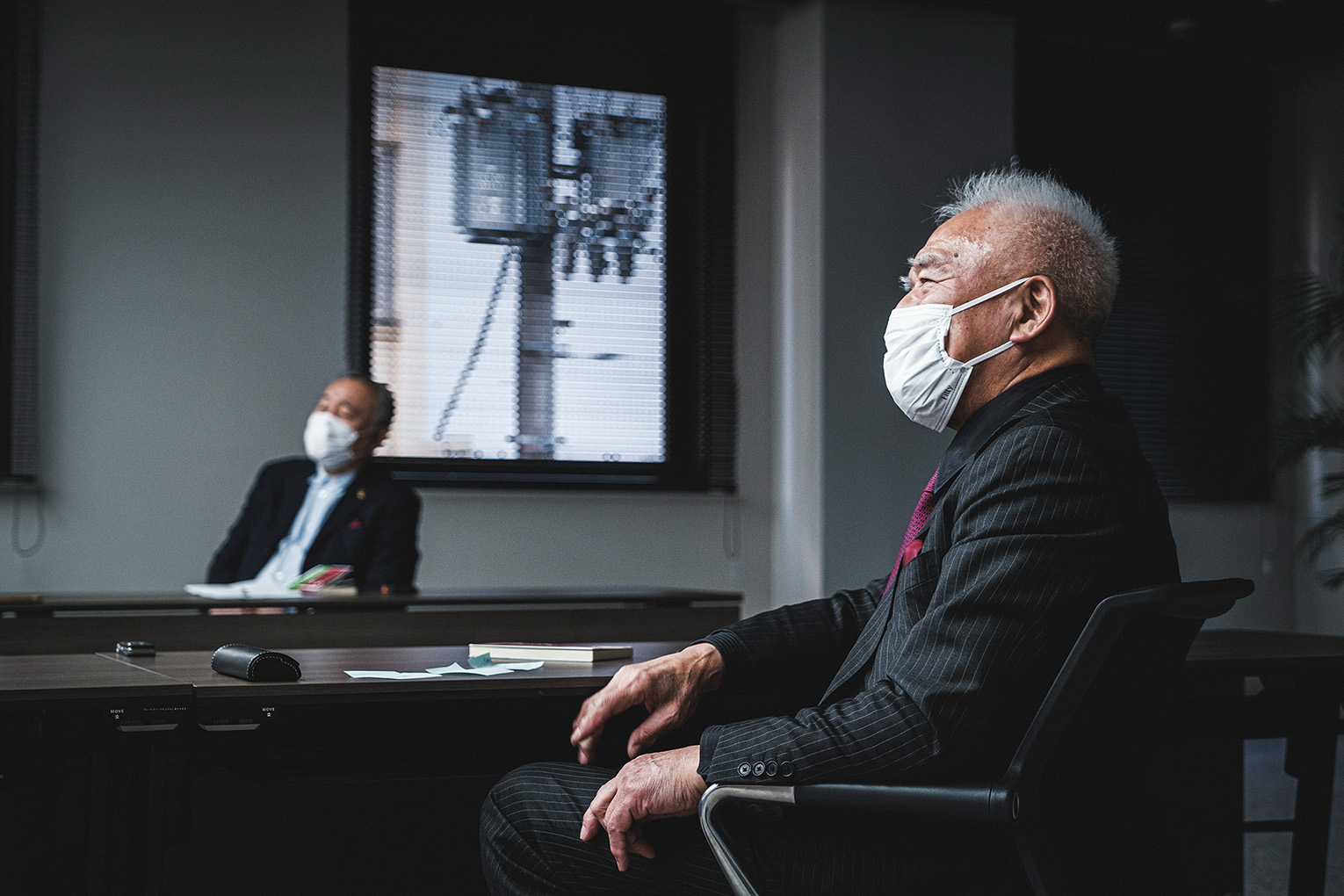
TATENO
That outfit was one of Tomo Koizumi’s?
OHTA
Yes. That’s why Mr. Morinaga’s fashion should continue to focus on interesting and memorable items as well as ideas that are different from what we’ve seen in the past, rather than on whether or not something will sell. Or, as he mentioned earlier, digital art should also be an important part of Mr. Morinaga’s work. The ordinary things that ANREALAGE places importance on are of course essential, but I think the mysterious and interesting thing about fashion design is its ability to find valuable assets hidden within the extraordinary that are waiting to be incorporated into everyday life. I hope you will keep doing your best in this regard.
MORINAGA
Thank you very much.
TATENO
In our catalogs, we carry both products that sell well and products that have capitalized on UNION’s technologies. If we didn’t include the latter, people would think that UNION only makes average or unremarkable products. This is why we place importance on highlighting the various technologies and designs we possess to the reader. My fear is that if we only made monotonous products, our technology would suffer as a result.
OHTA
I agree. Technology develops and evolves by taking on new challenges.
TATENO
The same is true for the fashion industry, isn’t it?
OHTA
It’s like an eternally unfinished work. Even if something remains incomplete after numerous times working on it, there may be something more important that lies beyond. I feel this is one element that is required of fashion now. Fashion is not just selling tons of clothes.
TATENO
Of course, companies hope that their clothing will sell. *Laughs.*
OHTA
Yes, that’s true, but I feel it is really important now for more surprising ideas to emerge that offer both culture and value in fashion.
TATENO
If I’m not mistaken, one of the things that Mr. Morinaga values is making things by hand. Of course, if you make things by hand, their numbers will be limited as they’re not mass produced, but I still find the process very attractive. Although handmade items are expensive, I place extra importance on them due to their limited number.
OHTA
The world is actively working to decarbonize, while shifting to electric vehicles that do not use oil. As electric cars powered by electric motors become ever more popular, we will no longer be driving cars where we can feel the vibration of the engine on the road. But I still think we need to keep a few of those gas-powered cars. There must be some value in that. Sooner or later, everyone will be driving electric cars that don’t make a sound. That alone will cause many people to think cars are not interesting at all. The same can be said for fashion.
MORINAGA
I completely understand what you’re saying. I have been driving a Toyota Origin since the year 2000, and I feel that enjoying the sound and vibration of the engine must be genetically ingrained in humans. Speaking of clothes, I think that buying and wearing clothes in virtual spaces will only increase in the future. However, considering the tens of millions of years of human history, I believe that the physical element of people wearing some sort of clothing will never lose out to owning clothes in the virtual spaces we’ve seen created over the past five years or so. I feel that this is where the strength of fashion ultimately lies.
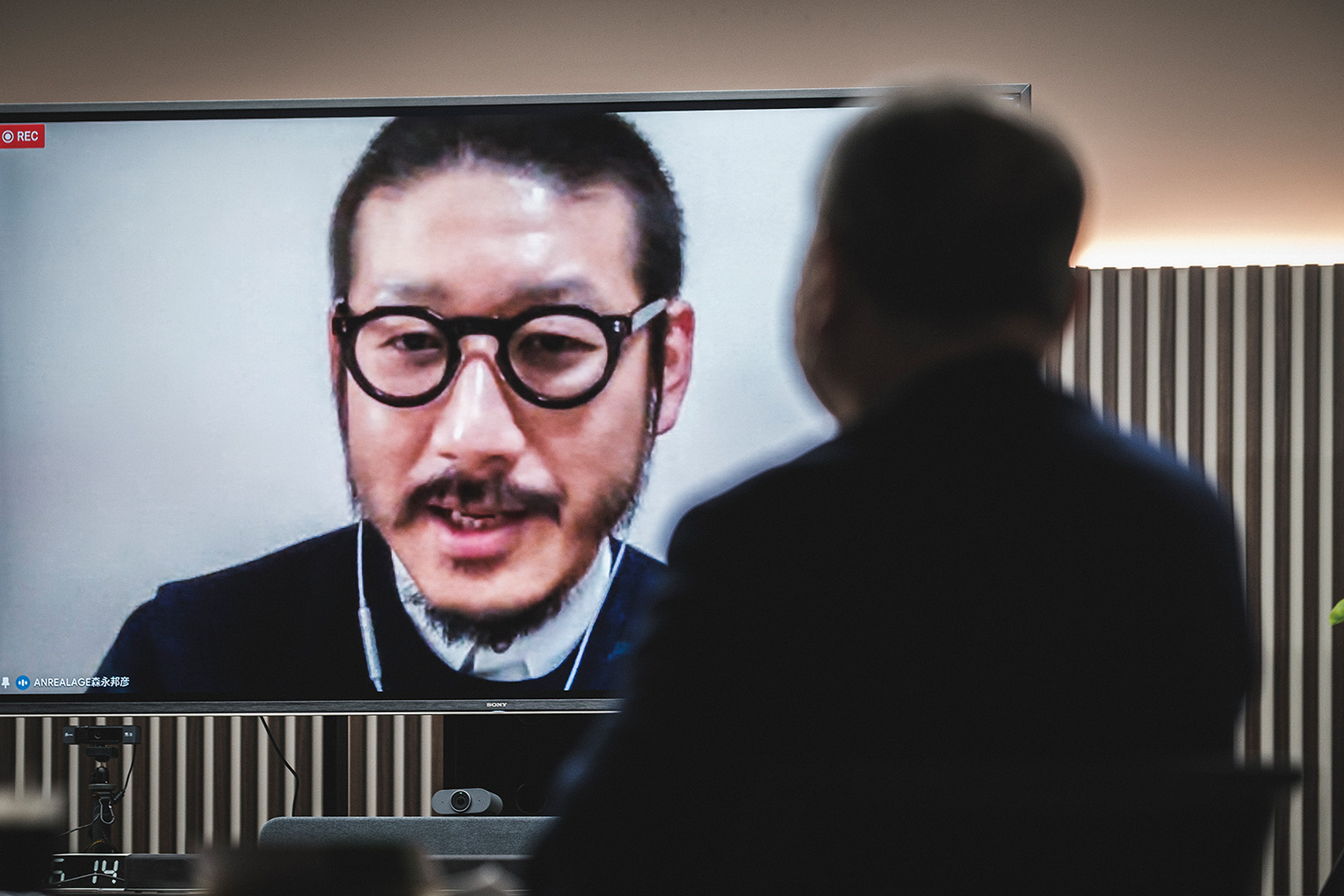
TATENO
I think there is no profession as wonderful as a fashion designer where you can see the clothes you have filled with your ideas and beliefs worn by someone else and enjoyed by so many. That said, I also imagine that there is great pain in creating something completely new. Do you come up with your ideas suddenly out of nowhere?
MORINAGA
In my case, I am the type of person who thoroughly observes a limited amount of things in a limited space to discover aspects of what I’m observing that I had not yet noticed. I rarely go to new places or travel to create my work. So maybe this 10-day isolation period is a good life for me. *Laughs.*
TATENO
*Laughs.*
MORINAGA
It may just provide the opportunity for me to revisit and inspect the things closest to me.
TATENO
I look forward to one day meeting you in person. Once things settle down in the world, please invite me to Paris.
MORINAGA
Definitely. I look forward to meeting you as well.
*Interview concludes*
Both
Thank you very much.

Planning: Naoyuki Miyamoto
Photography: Kesuke Kitaura
Writing: Fumiya Daito
Web Direction: Ryo Kijima